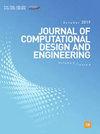Damage visualization and vulnerability assessment of surface ship considering the 3D multihit location of air-explosion threat
IF 6.1
2区 工程技术
Q1 COMPUTER SCIENCE, INTERDISCIPLINARY APPLICATIONS
引用次数: 0
Abstract
The purpose of this study is to propose a method for rapidly assessing the hit locations and extent of damage to a naval ship attacked by threatening weapons. An integrated method is presented for assessing the vulnerability to the hull and systems caused by the blast or penetrating effects of a weapon at multiple possible impact locations. The proposed method enables the assessment of vulnerability changes for design alternatives during the early design phase of naval vessels. To predict the extent of damage and to visualize the damaged hull and equipment, it is first assumed that a weapon has multiple hit locations. It is shown that a set of possible hit locations was generated by assuming the trajectory for air-explosion (AIREX) weapons by dividing the trajectory into an air-to-ship trajectory and a ship-to-ship trajectory. To account for the non-deterministic nature of weapon hits, a probability distribution approach was used to generate random multiple hit locations for each trajectory while the hit locations of AIREX in all directions were predicted using a multivariate probability distribution that generates three-dimensional random hit points. The extent of damage was then calculated, taking into account the topology of the hull structure and the equipment installed within the hull compartment, along with the damage volume associated with the weapon at each hit point. To identify the damage volume, axis-aligned bounding box (AABB) components were used, which provide a simplified representation of the ship’s geometry, as well as the relative position and dimensions of the hull structure and installed equipment. The damage compartment was defined as the portion of the hull that overlapped the damaged volume. While AABB’s overlap detection algorithm was applied to the damaged hull compartments, the algorithm identified the equipment that overlapped the damaged volume of the hull. Finally, the geometric modeling module, the probabilistic multiple hit location prediction module, and the damage analysis module were developed for damage visualization and vulnerability assessment.考虑空爆威胁三维多命中位置的水面舰艇损伤可视化与易损性评估
本研究的目的是提出一种快速评估受到威胁武器攻击的海军舰艇的击中位置和损害程度的方法。提出了一种综合方法,用于评估武器在多个可能的冲击位置的爆炸或穿透效应对船体和系统造成的易损性。提出的方法能够在海军舰艇的早期设计阶段对设计方案的脆弱性变化进行评估。为了预测损坏程度和可视化损坏的船体和设备,首先假设武器有多个命中位置。通过对空爆武器弹道的假设,将空爆武器弹道划分为空舰弹道和舰舰弹道,得到了一组可能的命中位置。为了考虑武器命中的非确定性,使用概率分布方法为每个轨迹生成随机多个命中位置,而使用多元概率分布来预测AIREX在各个方向的命中位置,从而生成三维随机命中点。然后计算伤害程度,考虑到船体结构的拓扑结构和安装在船体舱内的设备,以及每个命中点与武器相关的伤害量。为了识别损伤体积,使用了轴向包围盒(AABB)组件,它提供了船舶几何形状的简化表示,以及船体结构和安装设备的相对位置和尺寸。受损舱被定义为船体与受损体积重叠的部分。当AABB的重叠检测算法应用于受损船体舱室时,该算法识别了与船体受损体积重叠的设备。最后,开发了几何建模模块、概率多命中位置预测模块和损伤分析模块,实现了损伤可视化和易损性评估。
本文章由计算机程序翻译,如有差异,请以英文原文为准。
求助全文
约1分钟内获得全文
求助全文
来源期刊

Journal of Computational Design and Engineering
Computer Science-Human-Computer Interaction
CiteScore
7.70
自引率
20.40%
发文量
125
期刊介绍:
Journal of Computational Design and Engineering is an international journal that aims to provide academia and industry with a venue for rapid publication of research papers reporting innovative computational methods and applications to achieve a major breakthrough, practical improvements, and bold new research directions within a wide range of design and engineering:
• Theory and its progress in computational advancement for design and engineering
• Development of computational framework to support large scale design and engineering
• Interaction issues among human, designed artifacts, and systems
• Knowledge-intensive technologies for intelligent and sustainable systems
• Emerging technology and convergence of technology fields presented with convincing design examples
• Educational issues for academia, practitioners, and future generation
• Proposal on new research directions as well as survey and retrospectives on mature field.
 求助内容:
求助内容: 应助结果提醒方式:
应助结果提醒方式:


